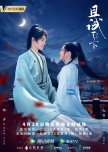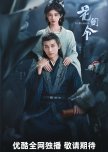

While The Best Thing and Amidst a Snowstorm of Love are distinct in terms of setting and plot, they share several thematic and narrative similarities, particularly regarding the central romance, the character development, and the emotional journey of the protagonists. Here's how these two dramas are similar:
1. Themes of Love and Revenge
Both dramas revolve around themes of love and revenge. In Amidst a Snowstorm of Love, the protagonist Yang Caiwei is murdered on her wedding day, only to be reborn with a desire for vengeance against her husband, Pan Yue. Similarly, in The Best Thing, the lead character is entangled in a complex relationship where love is complicated by past betrayals and unresolved emotional conflicts. Both stories explore how love can be both a source of healing and a catalyst for seeking justice or revenge.
2. Rebirth and Second Chances
A key element in both dramas is the concept of rebirth or second chances. In Amidst a Snowstorm of Love, Yang Caiwei is reborn after her murder and returns as Shangguan Zhi, determined to expose the truth behind her death and uncover the hidden truths about her past. In The Best Thing, the characters are also given the chance to reevaluate their relationships and past decisions, though the theme of rebirth might not be as literal. Both stories delve into how characters use their second chances to right past wrongs and seek emotional resolution.
3. Complex Relationships
Both series feature intricate, sometimes toxic, relationships where the characters' feelings evolve throughout the story. In Amidst a Snowstorm of Love, the relationship between Yang Caiwei and Pan Yue is marked by mistrust and betrayal, but over time, the truth behind their past begins to unfold, and their emotional journey evolves. In The Best Thing, the characters face similar challenges as they navigate their past issues and emotional scars, eventually realizing that love may still exist despite the complicated circumstances. Both dramas focus on how love can grow and change under challenging circumstances.
4. Emotional and Psychological Depth
Both dramas explore emotional and psychological depth, particularly through the protagonists' struggles with their pasts. In Amidst a Snowstorm of Love, Yang Caiwei’s quest for vengeance forces her to confront painful memories, and her transformation into Shangguan Zhi adds layers of complexity to her character. Similarly, in The Best Thing, the characters face internal conflicts and emotional baggage that affect their relationships and decisions. Both dramas delve into the psychological effects of betrayal, love, and revenge, making the characters' journeys emotionally resonant.
5. Strong Female Protagonists
In both dramas, the female protagonists are strong and determined, though they are shaped by different motivations. In Amidst a Snowstorm of Love, Yang Caiwei’s journey of rebirth and revenge showcases her strength, resilience, and growth. In The Best Thing, the female lead, though dealing with her own set of challenges, demonstrates resilience and the desire to confront her emotional past and move forward. Both characters are central to the story's emotional core and their development is key to the overall plot.
6. Intrigue and Plot Twists
Both dramas are filled with intrigue and plot twists that keep viewers engaged. In Amidst a Snowstorm of Love, the mystery surrounding Yang Caiwei’s death and the truth about her marriage to Pan Yue create suspense and tension. In The Best Thing, the evolving emotional dynamics and unexpected revelations about the characters’ pasts add intrigue to the storyline. Both series rely on the unfolding of secrets and the gradual discovery of hidden truths, making the plots unpredictable and captivating.
Both The Best Thing and Amidst a Snowstorm of Love center around themes of love, revenge, and personal transformation. The complex relationships, strong female protagonists, and emotional depth in both dramas make them similar in tone and narrative structure. If you enjoy dramatic stories about love, betrayal, and the emotional struggles of the characters, these two dramas offer a captivating watch with similar emotional and thematic undertones.
1. Themes of Love and Revenge
Both dramas revolve around themes of love and revenge. In Amidst a Snowstorm of Love, the protagonist Yang Caiwei is murdered on her wedding day, only to be reborn with a desire for vengeance against her husband, Pan Yue. Similarly, in The Best Thing, the lead character is entangled in a complex relationship where love is complicated by past betrayals and unresolved emotional conflicts. Both stories explore how love can be both a source of healing and a catalyst for seeking justice or revenge.
2. Rebirth and Second Chances
A key element in both dramas is the concept of rebirth or second chances. In Amidst a Snowstorm of Love, Yang Caiwei is reborn after her murder and returns as Shangguan Zhi, determined to expose the truth behind her death and uncover the hidden truths about her past. In The Best Thing, the characters are also given the chance to reevaluate their relationships and past decisions, though the theme of rebirth might not be as literal. Both stories delve into how characters use their second chances to right past wrongs and seek emotional resolution.
3. Complex Relationships
Both series feature intricate, sometimes toxic, relationships where the characters' feelings evolve throughout the story. In Amidst a Snowstorm of Love, the relationship between Yang Caiwei and Pan Yue is marked by mistrust and betrayal, but over time, the truth behind their past begins to unfold, and their emotional journey evolves. In The Best Thing, the characters face similar challenges as they navigate their past issues and emotional scars, eventually realizing that love may still exist despite the complicated circumstances. Both dramas focus on how love can grow and change under challenging circumstances.
4. Emotional and Psychological Depth
Both dramas explore emotional and psychological depth, particularly through the protagonists' struggles with their pasts. In Amidst a Snowstorm of Love, Yang Caiwei’s quest for vengeance forces her to confront painful memories, and her transformation into Shangguan Zhi adds layers of complexity to her character. Similarly, in The Best Thing, the characters face internal conflicts and emotional baggage that affect their relationships and decisions. Both dramas delve into the psychological effects of betrayal, love, and revenge, making the characters' journeys emotionally resonant.
5. Strong Female Protagonists
In both dramas, the female protagonists are strong and determined, though they are shaped by different motivations. In Amidst a Snowstorm of Love, Yang Caiwei’s journey of rebirth and revenge showcases her strength, resilience, and growth. In The Best Thing, the female lead, though dealing with her own set of challenges, demonstrates resilience and the desire to confront her emotional past and move forward. Both characters are central to the story's emotional core and their development is key to the overall plot.
6. Intrigue and Plot Twists
Both dramas are filled with intrigue and plot twists that keep viewers engaged. In Amidst a Snowstorm of Love, the mystery surrounding Yang Caiwei’s death and the truth about her marriage to Pan Yue create suspense and tension. In The Best Thing, the evolving emotional dynamics and unexpected revelations about the characters’ pasts add intrigue to the storyline. Both series rely on the unfolding of secrets and the gradual discovery of hidden truths, making the plots unpredictable and captivating.
Both The Best Thing and Amidst a Snowstorm of Love center around themes of love, revenge, and personal transformation. The complex relationships, strong female protagonists, and emotional depth in both dramas make them similar in tone and narrative structure. If you enjoy dramatic stories about love, betrayal, and the emotional struggles of the characters, these two dramas offer a captivating watch with similar emotional and thematic undertones.


Both Perfect and Casual and Because This Is My First Life explore unconventional relationships and delve into themes of personal growth, self-discovery, and the complexities of modern romantic relationships. While the settings and dynamics are different, these two dramas share several thematic elements and character-driven plots that make them quite similar:
1. Unconventional Relationships
At the heart of both Perfect and Casual and Because This Is My First Life is the development of unconventional relationships that challenge traditional ideas about love and commitment. In Perfect and Casual, the lead characters start a fake marriage due to circumstances, and over time, they slowly develop genuine feelings for each other. Similarly, in Because This Is My First Life, the main couple enters into a contract marriage, and through their time together, they discover new facets of themselves and each other, leading to a deeper, more meaningful relationship.
2. Focus on Self-Discovery and Personal Growth
Both dramas emphasize the importance of self-discovery and personal growth, particularly in the context of relationships. In Perfect and Casual, the protagonists are initially focused on their own goals and ambitions but gradually learn the importance of emotional connections and compromise. In Because This Is My First Life, the characters go through individual journeys of understanding themselves, their desires, and their aspirations, which ultimately shape how they view love and relationships. Both shows highlight how personal growth can influence romantic dynamics.
3. Challenging Societal Norms
Both dramas tackle societal expectations surrounding love, marriage, and career. In Perfect and Casual, the characters confront societal pressures regarding relationships and success, with their fake marriage serving as a critique of conventional romantic setups. In Because This Is My First Life, the series critiques the societal norms surrounding traditional relationships, living arrangements, and the pressures of adulthood, highlighting the challenges of balancing work, love, and personal life. Both shows address the concept of living authentically despite societal expectations.
4. Lighthearted Yet Thoughtful Exploration of Romance
While both series have elements of romance, they also maintain a lighthearted and comedic tone that makes them enjoyable to watch. In Perfect and Casual, the fake marriage dynamic provides humor and charm, while also gradually exploring deeper emotional connections between the characters. Because This Is My First Life also balances humor with more serious discussions about relationships, offering a thoughtful yet approachable exploration of love, commitment, and the complexities of modern life.
5. Strong Character Development
Both dramas are heavily character-driven, with a strong emphasis on the emotional growth of the leads. In Perfect and Casual, the relationship starts from a place of necessity, but over time, the characters learn more about their desires, vulnerabilities, and how to care for one another. Because This Is My First Life similarly focuses on character evolution, with each individual learning to navigate their personal issues, whether it’s emotional baggage, career struggles, or societal expectations. Both shows feature characters who evolve significantly throughout the series, and their personal growth is intertwined with their developing romantic relationships.
6. Themes of Friendship and Support
In both dramas, the importance of friendship and emotional support plays a key role. In Perfect and Casual, the characters’ evolving relationship is influenced by their growing understanding and support of each other. Similarly, Because This Is My First Life places significant emphasis on the role of friendships and the support systems that help the characters through difficult times. These strong emotional connections outside of the romantic relationships are central to the characters’ growth and success.
Both Perfect and Casual and Because This Is My First Life explore the nuances of modern relationships, focusing on personal growth, unconventional romantic setups, and the challenges of balancing love with individual goals. The blend of humor, thoughtful character development, and the critique of societal norms makes them similarly engaging for viewers who enjoy heartwarming and relatable romantic comedies with depth. If you liked the refreshing take on relationships in Because This Is My First Life, Perfect and Casual offers a similar vibe with its fake marriage dynamic leading to real emotional connections.
1. Unconventional Relationships
At the heart of both Perfect and Casual and Because This Is My First Life is the development of unconventional relationships that challenge traditional ideas about love and commitment. In Perfect and Casual, the lead characters start a fake marriage due to circumstances, and over time, they slowly develop genuine feelings for each other. Similarly, in Because This Is My First Life, the main couple enters into a contract marriage, and through their time together, they discover new facets of themselves and each other, leading to a deeper, more meaningful relationship.
2. Focus on Self-Discovery and Personal Growth
Both dramas emphasize the importance of self-discovery and personal growth, particularly in the context of relationships. In Perfect and Casual, the protagonists are initially focused on their own goals and ambitions but gradually learn the importance of emotional connections and compromise. In Because This Is My First Life, the characters go through individual journeys of understanding themselves, their desires, and their aspirations, which ultimately shape how they view love and relationships. Both shows highlight how personal growth can influence romantic dynamics.
3. Challenging Societal Norms
Both dramas tackle societal expectations surrounding love, marriage, and career. In Perfect and Casual, the characters confront societal pressures regarding relationships and success, with their fake marriage serving as a critique of conventional romantic setups. In Because This Is My First Life, the series critiques the societal norms surrounding traditional relationships, living arrangements, and the pressures of adulthood, highlighting the challenges of balancing work, love, and personal life. Both shows address the concept of living authentically despite societal expectations.
4. Lighthearted Yet Thoughtful Exploration of Romance
While both series have elements of romance, they also maintain a lighthearted and comedic tone that makes them enjoyable to watch. In Perfect and Casual, the fake marriage dynamic provides humor and charm, while also gradually exploring deeper emotional connections between the characters. Because This Is My First Life also balances humor with more serious discussions about relationships, offering a thoughtful yet approachable exploration of love, commitment, and the complexities of modern life.
5. Strong Character Development
Both dramas are heavily character-driven, with a strong emphasis on the emotional growth of the leads. In Perfect and Casual, the relationship starts from a place of necessity, but over time, the characters learn more about their desires, vulnerabilities, and how to care for one another. Because This Is My First Life similarly focuses on character evolution, with each individual learning to navigate their personal issues, whether it’s emotional baggage, career struggles, or societal expectations. Both shows feature characters who evolve significantly throughout the series, and their personal growth is intertwined with their developing romantic relationships.
6. Themes of Friendship and Support
In both dramas, the importance of friendship and emotional support plays a key role. In Perfect and Casual, the characters’ evolving relationship is influenced by their growing understanding and support of each other. Similarly, Because This Is My First Life places significant emphasis on the role of friendships and the support systems that help the characters through difficult times. These strong emotional connections outside of the romantic relationships are central to the characters’ growth and success.
Both Perfect and Casual and Because This Is My First Life explore the nuances of modern relationships, focusing on personal growth, unconventional romantic setups, and the challenges of balancing love with individual goals. The blend of humor, thoughtful character development, and the critique of societal norms makes them similarly engaging for viewers who enjoy heartwarming and relatable romantic comedies with depth. If you liked the refreshing take on relationships in Because This Is My First Life, Perfect and Casual offers a similar vibe with its fake marriage dynamic leading to real emotional connections.


Both The Long Ballad and Who Rules the World share several thematic and narrative similarities, particularly in their exploration of love, loyalty, political intrigue, and strong female leads in a historical setting. Here are the key aspects that make these two dramas alike:
1. Strong Female Protagonists
Both dramas feature powerful female leads who defy the traditional roles expected of women in their respective societies. In The Long Ballad, Li Changge is a skilled warrior seeking revenge for the loss of her family, and in Who Rules the World, Bai Fengxi is a fearless leader and martial artist with a sharp mind. Both women exhibit resilience, intelligence, and strength, taking charge of their own destinies in worlds dominated by men.
2. Political Intrigue and Power Struggles
Both series are set in historical contexts where political intrigue and power struggles are central to the plot. In The Long Ballad, the fight for the throne and the survival of the kingdom are key elements, as Li Changge navigates betrayal and manipulations at court. Similarly, Who Rules the World explores the political machinations and alliances in a world where rulers and factions vie for control. Both dramas deal with the consequences of power, loyalty, and betrayal in a turbulent political landscape.
3. Complex Relationships and Romantic Tension
Romantic relationships play a significant role in both series, where the protagonists find themselves entangled in complex emotional dynamics. In The Long Ballad, the developing relationship between Li Changge and Ashina Sun is marked by trust, betrayal, and a shared desire for revenge. In Who Rules the World, the romantic connection between Bai Fengxi and the equally skilled and intelligent male lead, Hei Fengxi, grows amidst their personal and political conflicts. Both relationships are built on mutual respect, tension, and the challenge of balancing personal feelings with larger goals.
4. Themes of Revenge and Justice
Both shows revolve around a central quest for justice and revenge. In The Long Ballad, Li Changge embarks on a journey to avenge her family’s death, which sets her on a path that intertwines with political power struggles. In Who Rules the World, Bai Fengxi seeks to uncover the truth behind past betrayals and bring justice to her people. In both stories, the protagonists are driven by a need to right past wrongs, and their actions lead to significant changes in the political landscape.
5. Action and Martial Arts
Both dramas are rich in martial arts and action, with both Li Changge and Bai Fengxi excelling in combat. Their skills and bravery in battle are central to their characters, and both women use their martial prowess to overcome challenges. The presence of complex fight scenes, strategy, and the portrayal of the characters' physical strength and leadership skills are key elements in both series.
6. Loyalty and Sacrifice
Loyalty and sacrifice are recurring themes in both dramas. In The Long Ballad, Li Changge is supported by a loyal group of allies who stand by her through thick and thin, despite the odds. Similarly, Who Rules the World emphasizes loyalty to family, friends, and the greater cause, with characters often making personal sacrifices for the greater good.
The Long Ballad and Who Rules the World share common threads of powerful female protagonists, intricate political plots, emotional depth, and action-packed storytelling. Both series revolve around themes of revenge, loyalty, and justice, with their central characters navigating the treacherous waters of political intrigue while balancing personal relationships. If you enjoy strong, multifaceted characters in historical settings with martial arts, romance, and power struggles, both of these dramas will captivate you.
1. Strong Female Protagonists
Both dramas feature powerful female leads who defy the traditional roles expected of women in their respective societies. In The Long Ballad, Li Changge is a skilled warrior seeking revenge for the loss of her family, and in Who Rules the World, Bai Fengxi is a fearless leader and martial artist with a sharp mind. Both women exhibit resilience, intelligence, and strength, taking charge of their own destinies in worlds dominated by men.
2. Political Intrigue and Power Struggles
Both series are set in historical contexts where political intrigue and power struggles are central to the plot. In The Long Ballad, the fight for the throne and the survival of the kingdom are key elements, as Li Changge navigates betrayal and manipulations at court. Similarly, Who Rules the World explores the political machinations and alliances in a world where rulers and factions vie for control. Both dramas deal with the consequences of power, loyalty, and betrayal in a turbulent political landscape.
3. Complex Relationships and Romantic Tension
Romantic relationships play a significant role in both series, where the protagonists find themselves entangled in complex emotional dynamics. In The Long Ballad, the developing relationship between Li Changge and Ashina Sun is marked by trust, betrayal, and a shared desire for revenge. In Who Rules the World, the romantic connection between Bai Fengxi and the equally skilled and intelligent male lead, Hei Fengxi, grows amidst their personal and political conflicts. Both relationships are built on mutual respect, tension, and the challenge of balancing personal feelings with larger goals.
4. Themes of Revenge and Justice
Both shows revolve around a central quest for justice and revenge. In The Long Ballad, Li Changge embarks on a journey to avenge her family’s death, which sets her on a path that intertwines with political power struggles. In Who Rules the World, Bai Fengxi seeks to uncover the truth behind past betrayals and bring justice to her people. In both stories, the protagonists are driven by a need to right past wrongs, and their actions lead to significant changes in the political landscape.
5. Action and Martial Arts
Both dramas are rich in martial arts and action, with both Li Changge and Bai Fengxi excelling in combat. Their skills and bravery in battle are central to their characters, and both women use their martial prowess to overcome challenges. The presence of complex fight scenes, strategy, and the portrayal of the characters' physical strength and leadership skills are key elements in both series.
6. Loyalty and Sacrifice
Loyalty and sacrifice are recurring themes in both dramas. In The Long Ballad, Li Changge is supported by a loyal group of allies who stand by her through thick and thin, despite the odds. Similarly, Who Rules the World emphasizes loyalty to family, friends, and the greater cause, with characters often making personal sacrifices for the greater good.
The Long Ballad and Who Rules the World share common threads of powerful female protagonists, intricate political plots, emotional depth, and action-packed storytelling. Both series revolve around themes of revenge, loyalty, and justice, with their central characters navigating the treacherous waters of political intrigue while balancing personal relationships. If you enjoy strong, multifaceted characters in historical settings with martial arts, romance, and power struggles, both of these dramas will captivate you.


Both Jun Jiu Ling and The Double share many thematic and structural similarities, particularly in how they explore intrigue, vengeance, and hidden identities within historical settings. Here are the key aspects that make these two dramas alike:
1. Vengeance and Redemption
In both dramas, the central characters are motivated by the desire for vengeance after being wronged. In The Double, Yang Caiwei is murdered on her wedding day and returns with a new identity to uncover the truth and seek justice. Similarly, in Jun Jiu Ling, the protagonist seeks to uncover the secrets of her past while fighting against those who have wronged her. The theme of redemption and righting past wrongs is a strong thread in both shows.
2. Historical Intrigue and Political Power Struggles
Both dramas unfold in a historical setting and focus heavily on political and familial power struggles. The Double is set against the backdrop of a sinful city where the characters battle for control and survival. Jun Jiu Ling, although set in a different historical period, similarly delves into the complexities of power, betrayal, and manipulation, particularly within the court and noble families.
3. Hidden Identities and Deceptive Appearances
A major similarity between Jun Jiu Ling and The Double is the theme of deception. In both series, characters hide their true identities to uncover hidden truths and navigate dangerous political environments. Yang Caiwei assumes a new identity after her rebirth in The Double, and similarly, the characters in Jun Jiu Ling often conceal their true motives and backgrounds to survive in a world of political machinations.
4. Complex Relationships and Betrayal
Both shows also focus on complex relationships marked by betrayal. In The Double, Pan Yue is initially believed to be the villain, but as the story unfolds, it's revealed that his love for Yang Caiwei was genuine. In Jun Jiu Ling, characters grapple with personal betrayals and the shifting dynamics of loyalty, particularly in a setting where trust is often tested.
5. Strong Female Protagonists
Both dramas feature strong female protagonists who, despite facing immense odds, navigate their worlds with intelligence, strength, and resilience. Yang Caiwei’s quest to uncover the truth and confront those who wronged her in The Double mirrors the determination and bravery of Jun Jiu Ling's heroine, who rises against adversity to uncover her family's secrets and fight for justice.
In summary, Jun Jiu Ling and The Double both center around deeply layered characters who seek justice and navigate a world rife with political intrigue, betrayal, and deception. Their journeys are marked by themes of revenge, hidden identities, and the struggle for power, making them highly similar in tone and narrative.
1. Vengeance and Redemption
In both dramas, the central characters are motivated by the desire for vengeance after being wronged. In The Double, Yang Caiwei is murdered on her wedding day and returns with a new identity to uncover the truth and seek justice. Similarly, in Jun Jiu Ling, the protagonist seeks to uncover the secrets of her past while fighting against those who have wronged her. The theme of redemption and righting past wrongs is a strong thread in both shows.
2. Historical Intrigue and Political Power Struggles
Both dramas unfold in a historical setting and focus heavily on political and familial power struggles. The Double is set against the backdrop of a sinful city where the characters battle for control and survival. Jun Jiu Ling, although set in a different historical period, similarly delves into the complexities of power, betrayal, and manipulation, particularly within the court and noble families.
3. Hidden Identities and Deceptive Appearances
A major similarity between Jun Jiu Ling and The Double is the theme of deception. In both series, characters hide their true identities to uncover hidden truths and navigate dangerous political environments. Yang Caiwei assumes a new identity after her rebirth in The Double, and similarly, the characters in Jun Jiu Ling often conceal their true motives and backgrounds to survive in a world of political machinations.
4. Complex Relationships and Betrayal
Both shows also focus on complex relationships marked by betrayal. In The Double, Pan Yue is initially believed to be the villain, but as the story unfolds, it's revealed that his love for Yang Caiwei was genuine. In Jun Jiu Ling, characters grapple with personal betrayals and the shifting dynamics of loyalty, particularly in a setting where trust is often tested.
5. Strong Female Protagonists
Both dramas feature strong female protagonists who, despite facing immense odds, navigate their worlds with intelligence, strength, and resilience. Yang Caiwei’s quest to uncover the truth and confront those who wronged her in The Double mirrors the determination and bravery of Jun Jiu Ling's heroine, who rises against adversity to uncover her family's secrets and fight for justice.
In summary, Jun Jiu Ling and The Double both center around deeply layered characters who seek justice and navigate a world rife with political intrigue, betrayal, and deception. Their journeys are marked by themes of revenge, hidden identities, and the struggle for power, making them highly similar in tone and narrative.


In Blossom and The King's Woman share several key similarities, especially in their exploration of love, betrayal, and the complexities of historical settings. Here are some of the notable aspects that make these two dramas similar:
1. Strong Female Leads Facing Betrayal and Rebirth
Both shows feature strong female protagonists who face betrayal and tragedy in their lives. In In Blossom, Yang Caiwei is murdered on her wedding day, only to be reborn and take on the identity of Shangguan Zhi to seek revenge and uncover the truth. Similarly, in The King's Woman, Zhao Ji is deeply loved by the king but faces betrayal and hardships due to political intrigue and her own sacrifices. Both characters are determined to fight against the forces that have wronged them and emerge stronger through their journeys.
2. Love Entangled with Politics and Power
In both dramas, love is intertwined with complex political situations. In In Blossom, Yang Caiwei’s relationship with Pan Yue is complicated by the schemes of powerful families and hidden secrets, while in The King's Woman, Zhao Ji’s love for the king is marred by court politics and royal conflicts. Both series explore how love and power collide, often leading to difficult choices and emotional turmoil.
3. Themes of Sacrifice and Redemption
Both dramas revolve around the themes of sacrifice and redemption. Yang Caiwei and Pan Yue must navigate a web of lies and uncover buried truths, while Zhao Ji’s story in The King's Woman involves sacrifice for love and the nation. In each story, the characters struggle to redeem themselves and each other, with love serving as both a source of strength and vulnerability.
4. Complex Relationships and Emotional Turmoil
The central romance in both dramas is marked by emotional depth and complexity. In In Blossom, the love between Yang Caiwei and Pan Yue is tested by misunderstandings and tragic circumstances, while in The King's Woman, Zhao Ji’s relationship with the king is fraught with tension and conflict due to their positions in society and the forces around them. These complicated relationships add layers of emotional drama, making both shows gripping to watch.
5. Intrigue, Revenge, and Uncovering the Truth
Both dramas feature a strong sense of intrigue, with the protagonists uncovering dark secrets and seeking revenge. In In Blossom, the mystery surrounding Yang Caiwei’s murder and the hidden truths about Pan Yue drive the narrative, while in The King's Woman, Zhao Ji faces political machinations and conspiracies that threaten her life and love. The process of uncovering these secrets keeps the story tense and suspenseful in both series.
In conclusion, both In Blossom and The King's Woman offer a rich blend of romance, drama, and historical intrigue. They are perfect for viewers who enjoy complex relationships, intense emotional arcs, and stories of love and betrayal set against the backdrop of political and royal conflict. If you enjoyed one, you will likely find the other equally captivating.
1. Strong Female Leads Facing Betrayal and Rebirth
Both shows feature strong female protagonists who face betrayal and tragedy in their lives. In In Blossom, Yang Caiwei is murdered on her wedding day, only to be reborn and take on the identity of Shangguan Zhi to seek revenge and uncover the truth. Similarly, in The King's Woman, Zhao Ji is deeply loved by the king but faces betrayal and hardships due to political intrigue and her own sacrifices. Both characters are determined to fight against the forces that have wronged them and emerge stronger through their journeys.
2. Love Entangled with Politics and Power
In both dramas, love is intertwined with complex political situations. In In Blossom, Yang Caiwei’s relationship with Pan Yue is complicated by the schemes of powerful families and hidden secrets, while in The King's Woman, Zhao Ji’s love for the king is marred by court politics and royal conflicts. Both series explore how love and power collide, often leading to difficult choices and emotional turmoil.
3. Themes of Sacrifice and Redemption
Both dramas revolve around the themes of sacrifice and redemption. Yang Caiwei and Pan Yue must navigate a web of lies and uncover buried truths, while Zhao Ji’s story in The King's Woman involves sacrifice for love and the nation. In each story, the characters struggle to redeem themselves and each other, with love serving as both a source of strength and vulnerability.
4. Complex Relationships and Emotional Turmoil
The central romance in both dramas is marked by emotional depth and complexity. In In Blossom, the love between Yang Caiwei and Pan Yue is tested by misunderstandings and tragic circumstances, while in The King's Woman, Zhao Ji’s relationship with the king is fraught with tension and conflict due to their positions in society and the forces around them. These complicated relationships add layers of emotional drama, making both shows gripping to watch.
5. Intrigue, Revenge, and Uncovering the Truth
Both dramas feature a strong sense of intrigue, with the protagonists uncovering dark secrets and seeking revenge. In In Blossom, the mystery surrounding Yang Caiwei’s murder and the hidden truths about Pan Yue drive the narrative, while in The King's Woman, Zhao Ji faces political machinations and conspiracies that threaten her life and love. The process of uncovering these secrets keeps the story tense and suspenseful in both series.
In conclusion, both In Blossom and The King's Woman offer a rich blend of romance, drama, and historical intrigue. They are perfect for viewers who enjoy complex relationships, intense emotional arcs, and stories of love and betrayal set against the backdrop of political and royal conflict. If you enjoyed one, you will likely find the other equally captivating.


The Legend of Shen Li and Love Between Fairy and Devil are two captivating fantasy romance dramas that share several similarities, both in terms of plot and emotional elements, making them perfect for fans of magical worlds and complex love stories.
1. Fantasy and Mythical World-Building
Both dramas are set in fantastical realms filled with mythical creatures, magical powers, and immortal beings. The world-building in both series is rich and immersive, creating a captivating backdrop for the romance and adventures that unfold. In The Legend of Shen Li, the characters are deeply connected to ancient myths and divine beings, much like in Love Between Fairy and Devil, where the story revolves around gods, demons, and fairies. This fantastical setting provides a perfect canvas for the epic scale of love and conflict.
2. Slow-Burn Romance with a Powerful Connection
One of the most striking similarities between the two shows is the slow-burn romance at the core of the story. Both Shen Li and Love Between Fairy and Devil feature an intense emotional connection between the leads that builds over time. The romance is not instantaneous but develops through trials, misunderstandings, and growth. The leads' relationships are filled with tension, chemistry, and passion, making every moment of their connection feel significant.
3. Themes of Sacrifice and Destiny
In both series, the protagonists are often faced with difficult choices that revolve around sacrifice and their sense of duty. In The Legend of Shen Li, the main characters struggle with their fates and responsibilities, much like in Love Between Fairy and Devil, where the lead characters' love is constantly tested by the forces of destiny and the expectations of their respective worlds. The theme of love transcending boundaries and the willingness to sacrifice for one another is central to both shows, providing emotional depth to their narratives.
4. Complex Characters and Development
Both dramas feature strong, layered characters who experience significant personal growth. The female leads in both series are strong, independent, and complex, often questioning their roles in the larger schemes of the world. Their male counterparts, while initially appearing to be stoic or distant, reveal their vulnerabilities and emotional depths as the story progresses. These character developments add richness to the narrative, making viewers invested in their journeys.
5. Stunning Visuals and Cinematography
Both The Legend of Shen Li and Love Between Fairy and Devil boast stunning cinematography and beautiful visuals. The use of costumes, set design, and CGI in both series brings the fantasy worlds to life in a visually stunning way. The breathtaking landscapes, magical battles, and romantic moments are captured with a high level of detail, making both dramas a feast for the eyes.
6. Themes of Forbidden Love
At the heart of both shows is the theme of forbidden love. The leads in both The Legend of Shen Li and Love Between Fairy and Devil come from different worlds, with their love being seen as taboo or forbidden by the societies they belong to. Their struggles to overcome these obstacles add an element of tension and drama to the plot, creating a captivating narrative that keeps viewers on the edge of their seats
1. Fantasy and Mythical World-Building
Both dramas are set in fantastical realms filled with mythical creatures, magical powers, and immortal beings. The world-building in both series is rich and immersive, creating a captivating backdrop for the romance and adventures that unfold. In The Legend of Shen Li, the characters are deeply connected to ancient myths and divine beings, much like in Love Between Fairy and Devil, where the story revolves around gods, demons, and fairies. This fantastical setting provides a perfect canvas for the epic scale of love and conflict.
2. Slow-Burn Romance with a Powerful Connection
One of the most striking similarities between the two shows is the slow-burn romance at the core of the story. Both Shen Li and Love Between Fairy and Devil feature an intense emotional connection between the leads that builds over time. The romance is not instantaneous but develops through trials, misunderstandings, and growth. The leads' relationships are filled with tension, chemistry, and passion, making every moment of their connection feel significant.
3. Themes of Sacrifice and Destiny
In both series, the protagonists are often faced with difficult choices that revolve around sacrifice and their sense of duty. In The Legend of Shen Li, the main characters struggle with their fates and responsibilities, much like in Love Between Fairy and Devil, where the lead characters' love is constantly tested by the forces of destiny and the expectations of their respective worlds. The theme of love transcending boundaries and the willingness to sacrifice for one another is central to both shows, providing emotional depth to their narratives.
4. Complex Characters and Development
Both dramas feature strong, layered characters who experience significant personal growth. The female leads in both series are strong, independent, and complex, often questioning their roles in the larger schemes of the world. Their male counterparts, while initially appearing to be stoic or distant, reveal their vulnerabilities and emotional depths as the story progresses. These character developments add richness to the narrative, making viewers invested in their journeys.
5. Stunning Visuals and Cinematography
Both The Legend of Shen Li and Love Between Fairy and Devil boast stunning cinematography and beautiful visuals. The use of costumes, set design, and CGI in both series brings the fantasy worlds to life in a visually stunning way. The breathtaking landscapes, magical battles, and romantic moments are captured with a high level of detail, making both dramas a feast for the eyes.
6. Themes of Forbidden Love
At the heart of both shows is the theme of forbidden love. The leads in both The Legend of Shen Li and Love Between Fairy and Devil come from different worlds, with their love being seen as taboo or forbidden by the societies they belong to. Their struggles to overcome these obstacles add an element of tension and drama to the plot, creating a captivating narrative that keeps viewers on the edge of their seats























